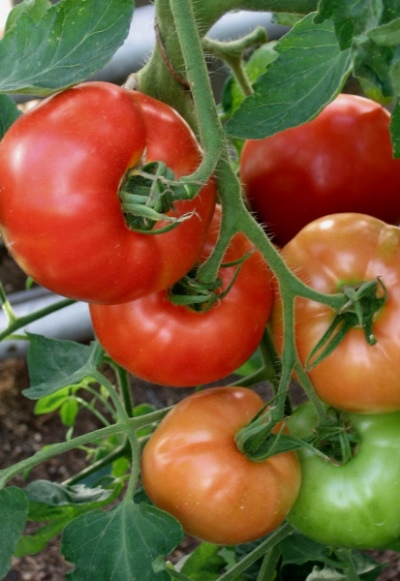
- Authors: Motov V. M., Vlasova E. A., Motova M. V. (OOO NPF "Agrosemtoms")
- Year of approval: 2007
- Category: hybrid
- Growth type: determinant
- Appointment: fresh consumption, for pickling and preserving, for juice
- Ripening period: early
- Ripening time, days: 115
- Growing conditions: for open ground, for film greenhouses, for greenhouses
- Bush height, cm: about 130
- Bush characteristic: strong
The Family tomato can indeed become a good companion for any family garden. But only diligent and attentive gardeners will be able to achieve a good result. And for this they need complete information about the plant.
Breeding history
The plant was developed at NPF Agrosemtoms. 3 leading breeders were involved in the project at once. Officially registered a crop for garden cultivation in 2007. She is by nature a hybrid.
Description of the variety
The family tomato shows typical features of determinant development. It is grown both in simple gardens, and in greenhouses under a film, and in greenhouses under glass. The bushes are very strong. Their height can reach 1.3 m. Medium-sized green leaves develop on the shoots.
You can grow such a tomato in:
various regions of the North Caucasus;
northern and northwestern regions of the European part of Russia;
the center of the European part;
Volga region;
Volgo-Vyatka and Central Black Earth regions.
The main qualities of the fruit
The green color is typical for the berries that appeared initially. A dark green area will form near the stalk. When ripe, the berries will be traditionally red. They are large and weigh on average 192 kg (maximum up to 350 g). Other features:
round geometric shape is typical;
the fruit is covered with a smooth skin;
the tomato will develop from a simple inflorescence.
Taste characteristics
The berries of the Family Tomato are sweet to taste. Be sure to note the balance of this taste. The pulp is firm and juicy. Expressive fleshiness is typical for her. The peel will not have a significant effect on the perception of berries.
Ripening and fruiting
The variety belongs to the early group. Under normal conditions, the fruits ripen 115 days after the first green shoots have hatched. Meteorological conditions and agricultural technology can affect the result quite strongly.
Yield
The collection of berries is up to 7 kg per 1 sq. m. The highest yield per 1 sq. m. m reaches 18.5 kg. The level of productivity varies depending on the agricultural technique and the actual cultivation conditions.
The timing of planting seedlings and planting in the ground
The time to sow seeds in containers filled with substrate comes in March or April. This can be determined more precisely only taking into account the actual and expected weather. If heated greenhouses are used, transplanting seedlings can be started in April. It is recommended to plant seedlings in open gardens in the second half of the first June decade. But due to the equipment in the garden of temporary shelters made of polyethylene, this period can be moved to May 15-20.

Growing tomato seedlings is an extremely important process, because it largely depends on whether the gardener will be able to harvest at all. All aspects must be taken into account, from seedbed preparation to planting in the ground.
Landing scheme
It is recommended to plant no more than 4 bushes per 1 sq. m. At the same time, it is advisable to be limited to 3 bushes altogether. The reason is obvious - it's easier to take care of the plantings this way.

Growing and care
This culture is quite resistant to late blight. And also declared resistance to cladosporium, tobacco mosaic and fusarium wilt. It is also worth emphasizing that the Family tomato can withstand temperature fluctuations. But nevertheless, it is advisable to play it safe and avoid hypothermia of the landings as much as possible. It is recommended to harvest the fruits until they are fully ripe, as they ripen perfectly outside the bush.
Mostly the bushes are formed into 2 stems. All side shoots must be eliminated. It is necessary to clean the stepsons every 5-7 days. The growing leaves will also have to be removed during the entire period of development. Since the plants will be powerful and will give a serious harvest, it is absolutely impossible to do without a garter to the supports.
It is traditionally necessary to water the plants in the early morning or late evening hours. The main thing is that the sun does not shine right after that. On a cloudy day, you can water at any convenient time. Top dressing is alternated using both minerals and organics. It is necessary to lay fertilizers every 10-15 days.




A plant needs different micronutrients at each stage of growth. All fertilizers can be divided into two groups: mineral and organic. Folk remedies are often used: iodine, yeast, bird droppings, eggshells.
It is important to observe the rate and period of feeding. This also applies to folk remedies and organic fertilizers.



























































































